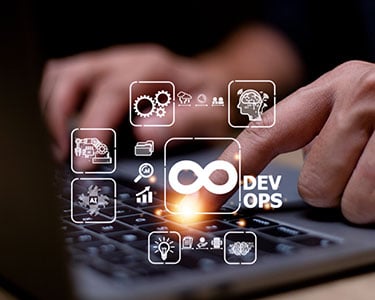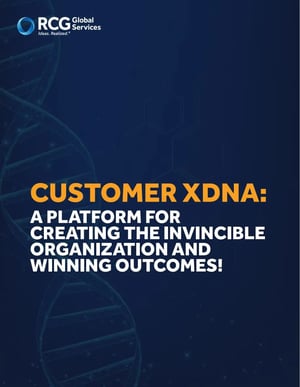Customer xDNA
A Platform for Creating the Invincible Organization and Winning Outcomes
Customer First: The foundation of Customer Segmentation

Customer xDNA is both a framework and a platform that will help you organize your thinking about how to think about customer experience management. But, even more importantly, it serves as a vital component of a platform to drive digital transformation through AI strategy and opportunities, real-time intelligent analytics and strategic decision-making, and hyper-personalization to enable the Sentient Enterprise: the new imperative in business decision-making and operations management.
With CxDNA, market and customer-focused business leaders can understand and proactively design their customer experience performance, key drivers, and impact of investment decisions empowered by real-time intelligent analytics, intelligent automation as a Sentient Enterprise.
First, we cannot overlook a foundational component of any customer experience effort and sentient enterprise platform: truly understanding customers.
It should be no surprise that your action must start with segmentation and persona development. In pursuit of the Sentient Enterprise and building the CxDNA, defining and understanding key customer/prospect groups is job one. This process of grouping customers into the top four to six segments/personas of individuals (B2C) or firms (B2B) who share common characteristics is called Customer Segmentation, each of which has its unique needs and value proposition requirements. This segmentation enables marketers to create targeted marketing messages for a specific group of customers, which increases the chances of the B2C or B2B customer buying a product or service. It allows them to create and use particular communication channels to communicate with different segments to attract them. More importantly, it helps you design experiences and focuses your efforts on delivering the correct differentiated value across the customer experience (CX) journey.
When you perform customer segmentation, you find similar characteristics in each customer’s behavior and needs. Then, those are generalized into groups to satisfy demands with various strategies.
While segmentation, as a concept, isn’t new, what is possible with AI, advanced analytics, data science, and machine learning is exploding. There are ever-evolving different products/ solutions available in the market, from packaged software to CRM products, clustering analysis, and custom models built with machine learning algorithms using Python. Data can be explored to “discover” segments based on various data elements (demographic, behavior, geographic, firmographic, etc.). The use of segmentation significantly increases success with customer acquisition and upsell by enabling:
- Targeted marketing activities to specific groups
- Launching features aligning with the customer demand, wants, and needs
- Development of the product roadmap focused on differentiated value by segment
- Profitability analyses and customer prioritization
- Designing personalized experiences throughout the customer lifecycle
What CxDNA is and How it Works

So, similarly, we have another analogy of two strands of activities. There is the customer action strand and the organizational action strand.
Customer Strand (customer jobs to be done)
From the customer’s standpoint, the customer is going through a series of steps or stages in their journey, on their experience that begins with discovery, and then learning about the problem that they have, looking at the evaluation of parts of possible solutions to their problem or the product that they’re looking for, then there’s the actual purchase decision. And finally, there’s the usage and engagement with the product, and the company, and advocacy; if they’re happy with the experience.
Organizational Strand (organization jobs to be done)
In parallel, what do you want to do as an organization, as a marketer, as a business?
The goals associated with the marketing funnel and customer lifecycle is that you want to reach customers, make them aware of your products and services and your brands, acquire them, which means that you want to bring them on board, get them to sign up with you, get them to try your products, services, solutions and then convert them into paying customers. You need to effectively create, communicate and deliver differentiated value on your customer’s terms.
After you convert prospects into paying customers, you must continue to use your organizational resources and capabilities to develop the customer relationship, get them to buy more frequently from you, buy more products from you, to increase the lifetime value. Next, you need to make sure that you retain your customer, that they don’t churn, that you don’t lose them. And finally, you want them to become loyal to you and to advocate for your company or your brand or your products to other people – maximizing their lifetime value.
Activating the CxDNA

This framework of jobs to be done is an advantageous way to think about the goals and expectations that customers have and have as a business. The jobs to be done are essential to creating and delivering the experience. It is also a beneficial way to think about the goals and expectations that customers have and your business. The jobs to be done are essential to creating and delivering the experience.
LEARN: The job to be done is, what are the possible solutions to this problem? That is what the customer wants to accomplish. In parallel, the jobs you as a Firm need to get done are to make customers aware that I exist initially. Here’s my brand, here are my solutions, here’s the value proposition – each specifically targeted to you:
EVALUATE: Customers want to assess the fit of the products and services available to them, their functional needs, and their emotional needs. At the purchase or buying stage, they need to decide where I buy, when do I believe, who I buy from, how much do I buy?
ENGAGE: The job that prospects/customers want to get done is, use of the product, service, solution. They want to learn how to use your product and interact with you as a company and your solution.
ADVOCATE: The job that the customer wants to get done is to share and repeat the positive experience that they’ve had with you.
While this upfront understanding and mapping are essential, the compelling challenge is to ACTIVATE the experience using Customer, financial and operational data that is fuel to the process to enable real-time streaming analytics, intelligent automation, prediction, and action – the heart of a Sentient Enterprise.
The Sentient Enterprise: a platform and ever-evolving journey

Sentient Enterprises can sense and predict micro-trends, shifts and quickly anticipate and adapt to market conditions. They can predict customer needs and engage them in personalized ways across the customer lifetime journey. Using Action and Insight engines powered by a data refinery and trusted data foundation, they lever real-time intelligent streaming analytics and AI and machine learning to create exceptional customer experiences.
At its core, the Sentient Enterprise consists of five essential characteristics of capability. These organizational capabilities are comprised of people, processes, and technology. The Sentient Enterprise can combine data, algorithms, and automation to make high-frequency decisions and actions without human intervention.
Why is this important? Fundamentally, the challenge we’re running into in the enterprise is agility at scale: How do you make decisions at data speed? Agility doesn’t like scale, and scale doesn’t like agility. From Marketing to Supply chain to Finance to Customer Engagement, your business model is likely ripe with the opportunity to increase critical business metric performance like revenue, share, profit, customer loyalty, and cost-effectiveness. But, Sentience and business at the speed of now enable a holistic approach to helping both strands of the Customer xDNA framework throughout the customer lifecycle to yield better insight for decision-making, reduced churn, optimized marketing investment, better targeting and segmentation, and delivering better overall customer experience.
The good news is that many key technology enablers support an enterprise’s digital transformation efforts, including intelligent analytics; including real-time insights and data about how consumers/prospects move through their world via intelligent analytics help to better understand and connect with customers.
The following characteristics mark the Sentient Enterprise (SE)- it is:
Five critical components enable the Sentient Enterprise with a hyper-focus on Data and Analytics Agility and High performance as an organization.
Agile Data supported by a Trusted Data Foundation and Data Refinery.
In RCG’s experience, this can involve a complete transformation of data management capability and infrastructure – to enable the enterprise on quality, timely data. Characteristics include:
- Layered, flexible architecture
- Self-service analytics supporting business users
- Real-time, responsive intelligence
- Agile analytics, AI, and rapid prototyping
Behavioral Data
What the Behavioral Data component does is address a new way of thinking and interacting. Instead of focusing on transactions, the organizations focus on behavior data and masses of data such as IoT and streaming data. This behavioral data is a gold mine of insight to help drive the business in decision-making and real-time action. This component requires building and maturing our analytics capability, information, and analytics delivery lifecycles to clarify such patterns and context. This enables prediction, real-time interventions and helps avoid problems. This capability is enhanced by enabling data scientists, business analysts, and other users within the data management architecture and ecosystem (trusted foundation and data refinery and pipeline) to move well beyond what is possible in a limited, transactional environment.
Features of the Behavioral Data component include:
- Capacity for 100x significant data volumes necessary to handle behavioral data that is both structured and unstructured
- Deep exploration and contextualization before data use
- Understanding patterns and interactions between transactions vs. just the transactions themselves
- Unleashing creativity, innovation, significant dialogue, and collaboration, and finding the right signals (including weak ones) from the noisy data environment
Collaborative Ideation
The Collaborative Ideation component is where we unleash the power of the organization at all levels with things such as crowdsourcing, collaboration, gamification, and social connections to connect humans and data in new and fast ways. Fundamentally, we prioritize the competence of principle “merchandizing analytic insights” across the business community. Like we merchandize products or social media trends online, we promote and recommend questions, people, and answers that an employee might be interested in based on his or her previous queries and activity.
Features of the Collaborative Ideation component include:
- Removes analytics barriers to use and adoption by removing silos and sharing best practices
- Empowerment and trust are enabled in the organization through lots of significant dialogue, white space, and social-media style collaboration, as well as the inculcation of supporting values
- Merchandizing analytic insights by promoting and recommending the most promising data sets and experiments
- “Analytics on analytics” for quality control and seamless governance of collaborative insight
Analytical Application
Analytical Application means building analytic insights into apps to enable repeatability and analytic follow-through across the business user in the organization.
In a more advanced capability, this includes simplifying the analytics development process and information delivery and analytics delivery lifecycle (IDLC and ADLC) and creates highly performant data engines that deliver. Easily accessible, packaged-up analytic workflows can be used again and again by business users throughout the enterprise. A focus is placed on “listening” to data vs. just the traditional ETL process, which focuses on people making requests of IT and data engineers to extract, transform, and load data.
Conversely, an ecosystem is created for app developers to “listen to data” and its “context” in real-time.
Features of the Analytic Application component include:
- Packaging analytic workflows by packaging them as reusable apps
- Effectively Defining and governed analytic delivery lifecycle and information delivery lifecycle
- Real-time, intelligent “Listening” to data versus retrospective review
- Zero-cost deployment of apps without added stress for IT.
- Implementation and use of “Analytics on apps” for quality control and optimization of app-driven insights
Intelligent, Autonomous Decision-Making: Getting to Sentience
Any company that desires to survive in the future, ten years or more out, needs to utilize vast amounts of data around its customer and organizational capability, performance engine to optimize human-data-machine interactions to create and deliver value.
Sentience is enabled in an enterprise through Autonomous Decisioning through the deployment of AI, machine learning at scale to tackle the massive work of data sorting/filtering and management and analytics from manual processes to intelligent automated solutions and digital workers. The algorithmic capabilities make the enterprise more autonomous. By connecting complex algorithmic processes throughout the business, helps the company act more like a proactive organism. Sharing and “self-decisioning algorithms” are spread throughout the enterprise, which improves inter-functional coordination, information generation, and dissemination, and automation, resulting in the creation of a system-of-systems that builds capacity to the point at which the organization essentially becomes “self-aware” almost like a live organism that can sense things and be proactive with trends, forecasts, decisions, and strategies. Thus, a more sentient enterprise has the capability and capacity for making strategic decisions and resource allocations fueled by better understandings enabled by the tremendous breadth and depth of data at its disposal.
Key Features of the Autonomous Decisioning Platform
- Driving self-awareness by automating decisions and organizational functions
- Sensing and responding to circumstances with fast, accurate, and intelligent algorithms
- Deploying artificial intelligence for deeper analysis and decisions around complex use cases “Analytics on algorithms” to refine and optimize algorithms for continuous improvement and better performance
Agile and Trusted data Foundation (TDF) with Data Refinery

This requires a strategic approach to information management. When organizations can make trusted data a priority through information architecture, non-technical users can analyze vast amounts of raw data, a company-wide catalog to find data across the enterprise can be created with data quality processing and data governance to achieve more manageable tasks but to serve as business accelerators to the “performance engine” engine of the firm.
Critical task environments to enabling a TDF include:
Enterprise Data Warehouse Offloading
- Moving data integration workloads, also called Extraction, Transformation, and Loading (ETL) workloads, from the EDW (or elsewhere) to the data lake
- Moving unused data from the EDW to the data lake
- Store new types of data—often unstructured or semi-structured—in the data lake for enriching traditional EDW analytics
Governed Data Lake
- Establish business terms that data stewards manage
- Create a business glossary, tying the business terms to the underlying data assets
- Support complete data lineage reporting and cross-tool impact analysis
Meet Regulatory and Compliance Needs
- Solve complex data integration, data quality, and data governance challenges created by siloed data repositories, applications, and data integration teams
- Implement comprehensive data quality processing and data governance
Enable 360-Degree Information-Driven Insights with Master Data Management
- Manage critical enterprise master data, as spread across siloed systems, to generate actionable insight, create instant business value alignment and comply with data governance, rules, and policies
- Plot an organization’s data throughout the complete information and analytics lifecycle with a highly configurable framework that supports on-premises and cloud-based IT architectures and models
Building trust in the data needs to be transparent and secure, with good data governance, data quality, and data cleansing processes in place, which includes:
- Standards creation
- Tool selection (automation vs. hand-coding etc.)
- Design for / Assure Ease of use.
- Prioritize data quality
- Prioritize metadata management
- Data Cleansing
- ID Corrupt Data
- Delete, correct, and update each record as needed.
- Data stewardship
The main phases of effort are required when establishing the Trusted Data Foundation and Data Repository:
- Understanding the data you have and the data you need to develop or acquire—and what you need to create a solid foundation and drive data-based insights.
- Determining key data sources and what should feed the Trusted Data Foundation (and Data Lake) – Align different databases/sources
- Determining the organizational strategies and actions regarding:
- Data quality
- Tools and Architecture
- Data stewardship
- Advanced Analytics & responsive intelligence
- Self-Service
- Information delivery lifecycle (IDLC) and Analytics delivery lifecycle (ADLC)
- Enterprise Data Warehouse Offloading
- Move data integration workloads, also called Extraction, Transformation, and Loading (ETL) workloads, from the EDW (or elsewhere) to the data lake.
- Move unused data from the EDW to the data lake.
- Store new types of data—often unstructured or semi-structured—in the data lake for enriching traditional EDW analytics
- Provide a Governed Data Lake
- Establish business terms that data stewards manage
- Create a business glossary, tying the business terms to the underlying data assets
- Support complete data lineage reporting and cross-tool impact analysis
- Meet Regulatory and Compliance Needs
- Solve complex data integration, data quality, and data governance challenges created by siloed data repositories, applications, and data integration teams
- Implement comprehensive data quality processing and data governance
- Enable 360-Degree Information-Driven Insights with Master Data Management
- Manage critical enterprise master data, spread across siloed systems, to generate actionable insight, create instant business value alignment, and comply with data governance, rules, and policies
- Plot an organization’s data throughout the complete information lifecycle with a highly configurable framework that supports on-premises and cloud-based IT models
Building trust in the data. It needs to be transparent and secure, with good data governance, data quality, and data cleansing processes in place; this includes enacting the following:
- Standards creation
- Tool selection (automation vs. hand-coding etc.)
- Ease of use
- Prioritize data quality
- Prioritize metadata management
- Data Cleansing
- ID Corrupt Data
- Delete, correct, and update each record as needed.
- Data stewardship
Three main areas are addressed when establishing a Trusted Data Foundation that will support the Sentient Enterprise and winning customer experience:
The ability to drive data listening and build an agile and trusted data foundation begins with a strategy for information management that promotes standards and reuses resources across the enterprise. A Guiding Principle is to “Think big—but start small and move in an agile fashion.”
Although you can approach your information and data management strategy with one building block at a time, you must consider the big picture every step of the way (such as by using a digital strategy roadmap). Laying the proper groundwork for analytics prevents paralysis by bad data. For example, you may want to start with a data quality project to clean up your customer data during the extraction, transformation, and load (ETL) process. Subsequently, you may want to leverage the same cleansing rules to improve your customer data at the operational customer relationship management (CRM) source system.
The information architecture should be built once and used across the enterprise to address the most prevalent business challenges. If needed and appropriate, it can also be spearheaded in a business unit on a programmatic level. Nevertheless, an enterprise perspective is essential.
The Trusted Data Foundation should enable innovation with insights together with compliance; and that in turn
- Implements an information architecture that supports artificial intelligence
- Governs a/the data lake
- Enables self-service analytics and responsive intelligence
- Enables data listening and the behavioral vs. transactional component
- Levers the power of both structured and unstructured data
Along the way, we need to select and implement tools-based evaluation of the merits of their Ease of use, data quality, and end-to-end metadata management.
Scaling Sentience into action: Conversational AI for Customer xDNA and Intelligent Innovation

Predictive and “smart solutions” and streaming, real-time data, analytics, and decision-making are moving A.I./Intelligent and cognitive solutions into customer-facing processes and experiences, not just the back office or embedded product and service.
In addition to data listening, predictive analytics includes analytics as a service and the collaboration of data scientists, engineers, and subject matter/ business experts to drive much more democratization of AI, machine learning, advanced cognitive analytics. Most importantly, the three keywords we see now are “Intelligence/ Sentience”, “at Scale” and “customer experience.”
Enabling Invincibility
An organization that constantly reinvents itself before it becomes obsolete. The invincible company explores the future while excelling at exploiting the present. It cultivates an innovation and execution culture that lives in harmony under the same roof. It competes on super business models and transcends traditional industry boundaries.
An invincible company constantly reinvents itself, competes on superior business models, and transcends industry boundaries. Three places occur in a business model architecture:
- The customer/target customer
- The value propositions
- The value creation architecture
The Customer xDNA framework as a platform is a gamechanger in serving the focus on these three areas as enabled by the business model by way of the Agile and Trusted Data Foundation, Real-time streaming data, data listening and AI, Intelligent Automation to build a sentient enterprise that powers high-performance engine to deliver differentiated and winning customer relationships.
Help is here: RCG Global Services

We are here to help make it all REAL, especially in your journey to be a Sentient Enterprise. We would love to partner with you. Please let us know how we can help.
Whether you need help with data science like market segmentation to the design and implementation of a. modern data architecture and agile and trusted data foundation to the development of a CxDNA roadmap or digital strategy or the development and implementation of cognitive applications or even managing your apps and services, RCG is your partner in achieving your digital ambitions and getting more brilliant, faster results.
Additional Resources from RCG Global Services
- The Sentient Enterprise E-Book
- The New Imperative: Incredible Customer Experience – Using Customer xDNA to get there faster
- Sounds Simple … But is it Easy? Identity Resolution & Hyper personalization
- Business at the Speed of Now E-Book
- Hyper personalization: Connect to your market of one
- Focused on Growth? Accelerate Your Workforce Digital Acceleration
- Hyperlocalization: Provide a stellar customer experience
- 5 Steps to Trailblaze your AI Journey
- Proximity Marketing and Ad Optimization
- Beyond the hype: 9 Secrets to Get your AI Game On!
- Supercharge Your Customer Engagement Initiatives with AI – Right Now
- Conversational AI for Customer xDNA and Intelligent Innovation at Scale
Works Cited
- https://rcgglobalservices.com/conversational-a-i-for-customer-xdna-and-intelligent-innovation-at-scale/
- https://rcgglobalservices.com/the-new-imperative-incredible-customer-experience-using-customer-xdna-to-get-there-faster/
- https://customerthink.com/2021-customer-experience-trends-and-tactics/
- https://www.forbes.com/sites/adrianswinscoe/2020/12/17/11-customer-experience-related-predictions-for-2021/
- https://www.stevenvanbelleghem.com/blog/8-customer-experience-trends-for-2021/
- The Customer xDNA framework has been developed by Dr. Mohanbir Sawhney at Northwestern University, Evanston, IL.
- The Three Box Solution: Create the Future, Forget the Pat, and Manage the Present. Vijay Govindarin, Ph.D. Harvard Review Press
- The Sentient Enterprise by Dr. Mohanbir Sawhney
- Building the Sentient Enterprise White Paper (http://www.Teradata.com )
- https://www.vainu.com/blog/how-to-build-data-foundation/
Download a PDF version of this ebook by filling out this form

Please fill out the form to download the PDF.

